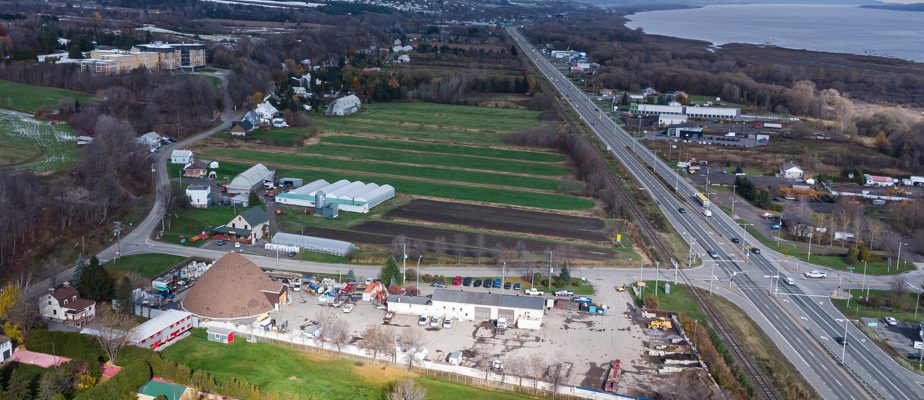(Château-Richer) A handful of citizens and heritage defenders denounce the construction of an imposing building “in the oldest lands of Quebec”, not far from the heritage Avenue Royale and the very busy Boulevard Sainte-Anne.
For his part, the owner of an excavation company asserts an acquired right dating back to the 1970s, when certain industrial activities were permitted on his land surrounded by fields.
“A lot of people say: “In any case, Boulevard Sainte-Anne is already ruined…” But it is here, for almost four kilometers, that there remains the last showcase of the agricultural landscape on the Côte- de-Beaupré,” notes Louis Painchaud, professor emeritus at the faculty of theology and religious sciences at Laval University.

PHOTO EDOUARD PLANTE-FRÉCHETTE, LA PRESS
Louis Painchaud in front of his heritage house on Avenue Royale
“In other words, Château-Richer is what remains,” he said. The landscapes here are therefore all the more precious. »
Louis Painchaud welcomes us in an ancestral house built by his great-great-grandparents. We are in Château-Richer, about twenty kilometers east of Quebec.

From Mr. Painchaud’s land, which overlooks Avenue Royale, you can see Boulevard Sainte-Anne. Anyone who has ever been to Côte-de-Beaupré or Charlevoix knows Route 138 well, on the edge of which residences, businesses and industries intermingle in often very relative harmony.
But some heritage defenders point out that the north side of this road has largely retained its agricultural vocation for a handful of kilometers. It is this part that opponents of the Gosselin Tremblay Excavation expansion project are trying as best they can to protect.

PHOTO EDOUARD PLANTE-FRÉCHETTE, LA PRESS
Farmer Nicolas Tremblay
“Here, we are in the oldest lands of Quebec, of New France. It is here that the first settlers settled on Côte-de-Beaupré. There is little left of these landscapes,” notes farmer Nicolas Tremblay, who lives nearby.
The disputed plot of land lost its agricultural use when the government built road equipment there to maintain Sainte-Anne Boulevard in 1970. Gosselin Tremblay Excavation bought the land in 2009. The company has since occupied the old buildings.
But its approximately 70 employees are cramped, explains the owner. He wants to invest a little more than 3 million to expand operations.
“Yes, we have an excavation company between two agricultural lands,” notes owner Bruno Gosselin. But decisions were made in the 1970s. We are a private company, we cannot build a park and move! »

IMAGE PROVIDED BY THE CITY OF CHÂTEAU-RICHER
The new offices that the excavation company wants to build
Opponents fear that the new two-story building will disfigure the landscape. But Bruno Gosselin assures that it will be barely visible from the heritage Avenue Royale. He argues that he will demolish old, unaesthetic buildings, including the famous 55-foot-high “igloo” which served the ministry in the past.
“We have buildings from the 1960s that are not insulated,” he says. We want to be in up-to-date premises. »

PHOTO EDOUARD PLANTE-FRÉCHETTE, LA PRESS
Gosselin Tremblay Excavation argues that it wants to demolish old, unsightly buildings, including the famous “igloo” which served the ministry in the past.
In accordance with the rules of the art, says the mayor
The mayor of Château-Richer assures that all steps were taken according to the rules of the art. Gino Pouliot supports the expansion of the facilities, like the majority of his population, he says.
For the moment, the population is favorable to the project. That’s what people tell me. We meet people, we talk. People ask me: “But why do people disagree?” People are concerned about the appearance, the fact that it will somewhat obstruct the view of the heritage landscape, according to them.
Gino Pouliot, mayor of Château-Richer
“But the heritage landscape is not something we can act on as we speak,” adds the mayor.

PHOTO EDOUARD PLANTE-FRÉCHETTE, LA PRESS
The mayor of Château-Richer, Gino Pouliot, supports the expansion project.
In 2011, Quebec created the new legal status of “Heritage Cultural Landscape”. But it is the municipalities that must request this status. The latest news is that only Rivière-Ouelle, in Bas-Saint-Laurent, has taken steps to obtain it.
The opponents received the support of the Action Patrimoine group, which wrote to the mayor. But so far, their efforts have been in vain.
They also deplore the style of the building. “People think they are coming to pick apples in the countryside and will find themselves in front of an industrial building like you find in the Saint-Augustin industrial park. There is confusion there,” believes Nicolas Tremblay.

PHOTO EDOUARD PLANTE-FRÉCHETTE, LA PRESS
In an ideal world, they say, the business would have moved to the south side of Sainte-Anne Boulevard. This sector is already reserved for commercial and industrial activities. And what they consider to be a “mistake of the past” would have been repaired by removing industrial use from the land.
The company has evaluated moving options, notably to another municipality, explains the mayor. These efforts failed, to the great relief of Mayor Pouliot. Château-Richer must urgently redo a large part of its infrastructure.
“I’m glad it didn’t work,” he said. We want to keep businesses, it’s the vitality of a city, it’s what brings grist to the mill. They have 74 employees. It’s families. These people consume at Château-Richer. »
